
Printable Grocery Price Book
Use It To Compare Grocery Prices In Your Area
A grocery price book is used to compare grocery prices in your area, to know what the rock bottom sales price is and predict sales cycles.
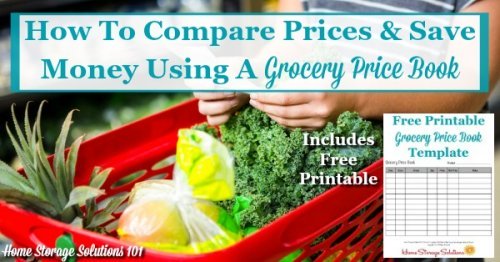
First, I'll tell you how to use this useful grocery price list or book to your advantage, and hopefully convince you why you should create one for yourself. Then, below, I'll give you a free printable template you can use to create your own.
Why Should I Compare Grocery Prices?
Prices for groceries can vary greatly, both at various stores and at various times of the year, or during different sales cycles.
I'm not sure what the reason is that grocery stores and supermarkets use a sales cycle, but I know they do. This means some sales are better than others, and typically the same rock bottom sales happen on a regular, although infrequent basis.
Plus, I know from experience that sometimes so called "sales" are no better than the regular price in the store, and I don't want to feel like I got a bargain when I really didn't.
Finally, I've found that if you pay attention to prices between stores, you'll notice that certain items are consistently cheaper at one store, and another is consistenly cheaper at another store.
Every penny counts, and if you've got a tight budget like many of us these days throwing away money by buying things for a higher price than necessary is just not a luxury we can afford.
How Can A Grocery Price Book Help Me With My Grocery Price Comparisons?
You can typically remember a couple prices here and there, especially on items you buy week after week. However, I've got to use my mind for lots of things, especially keeping track of kids, work, etc., and I don't have a lot of extra brain power left for remembering the price of canned green beans in Walmart versus the grocery store.
That's where a grocery price book can come in. Put your brain on paper, so you can actually see if that advertised (or unadvertised) sale is really a good deal or not while you're walking through the grcoery store aisle or studying the week's circular ads.
Plus, once you've worked on your grocery price book for a while, and collected data for about three months or longer, you'll start to learn even more stuff by comparing historical prices, and being able to study and compare the differences in unit prices at various stores.
Yes, you could figure this stuff out in your head, but having it all organized in one place, on paper, often can give you that "ah ha" moment that puts the pieces of the grocery price comparison puzzle together for you.
For instance, here are some advantages to creating and using a grocery price book:
- Detect price and sales cycle, including by season
- Know when you're getting a rock bottom bargain
- Find trends to help you decide which stores to shop at, for what types of items
- The book can help you stock up on items while they're the cheapest you'll find, and also lets you know how many of an items to stock up on between sales cycles to suit your family's needs
- Choose when to maximize your use of coupons by pairing the coupon with the low sale price for the biggest savings
One reader, Holly, wrote in to share with me her experience with using a price book. She said:
This thing changed the way I shop and saved me a ton of money! Over the years as I've shared it with friends it has helped them too.
How To Use Your Grocery Price Book To Compare Grocery Prices In Your Area
Each family is different in what they typically buy, and also in where they shop. Therefore, creating your own personalized grocery price list to compare prices will help you the most in maximizing your savings.
One of the keys to using a grocery price book effectively is to calculate the unit price.
We've all heard the general rules that buying in bulk, such as at a warehouse store, is cheaper, or that bigger containers have a lower unit price than smaller containers. While these general rules do have some grains of truth in them, you may be suprised when you compare the unit price to figure out this isn't always the case, especially with big sales or when you also use coupons.
You may find that while the bulk cans of green beans cost lest per unit at the warehouse store most of the time, when the grocery store has their rock bottom lowest sales prices on the smaller cans that this is actually the cheapest price. Plus, these smaller cans are a more convenient size for your family's use. In such a situation the grocery price list will make you confident in your decision to skip the warehouse store and instead wait for the supermarket sale, and when it rolls around you can stock up enough cans for your family until the sale rolls around again.
To calculate the unit price a bit of math is required, so I tend to grab a caculator for this task. To determine the unit price divide the cost of the item by the number of units, such as ounces, sheets, feet, etc.
If you shop at a supermarket the unit price is often listed for you on the shelf itself, next to the price of the item. But be careful -- always compare apples to apples when it comes to the unit price.
Sometimes, especially if you're comparing bulk items with the smaller versions, different units of measurement are used, such as ounces versus gallons. You've got to make sure you're using the same unit of measurement to compare, or your comparisons won't make any sense.
How To Create Your Own Grocery Price List Or Book
I hope I've convinced you that it's worth the time to compare grocery prices, and that a grocery price book is a good way for you to do it.
You can go very low or high tech with your price list, from a small spiral notebook, to a computer spreadsheet. I tend to be a middle of the roader and suggest a binder using a template, such as the one I've created for you below.
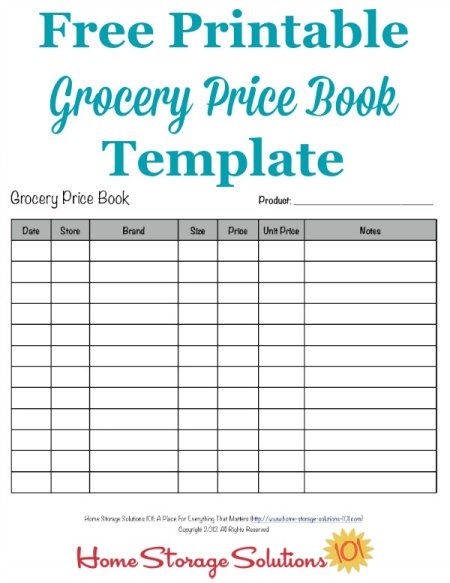
Click here for free printable template
(opens in another window as PDF)
Print one page for each of the typical items you buy on a regular basis, and fill out the product in the right hand corner. Put them in a three ring binder, in alphabetical order. You can categorize by type of products too, and put them in different sections, if you wish.
Using a grocery price book to compare grocery prices works best for cleaning and laundry supplies, household goods, and non-perishable food items -- basically things you can stock up on while prices are low. Therefore, focus most on these items. Don't forget meat or produce sales though, especially if you can freeze items for use later.
Then comes the most tedious part, which is filling out the information for the first couple of weeks. I suggest using your itemized grocery receipt to help you along since it will tell you most of the information you need to know.
Here are the categories I suggest taking note of:
- Date
- Store name (you may write this in shorthand to save space)
- Brand
- Size
- Price
- Unit price
- Notes - this section can be used to write down any coupons you combined with a sale for a good final unit price, and/or to note when you purchased something. Eventually, this information will help you know how much of an item you should stock up on between sales to suit your family's needs.
After a while you don't need to always write down every price, but instead just note special sales or price increases you see while shopping. Most sales cycles are between six weeks and three months, so after that amount of time you'll really begin seeing some helpful trends emerging from your list.
If you're anxious to begin reaping the benefits of all this information even more quickly you can also review sales ads and place information from them into the price book as well.
When you go to the grocery store I suggest taking your grocery price book with you, along with a pen and calculator. You can jot down notes of sales, even if you choose not to buy an item at that time, and can use the calculator to quickly figure the unit price.
In addition, you can reference the book as needed while shopping if you come across an item that seems like a good bargain, and confirm it really is a great deal, or pass it up if you predict a lower price is coming soon in the sales cycle.
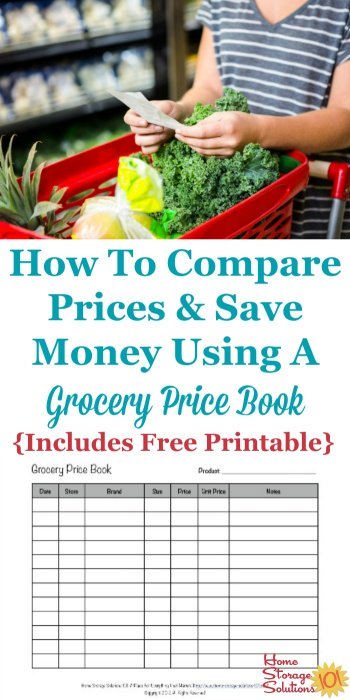
More Couponing Resources On The Site For You
Here are some additional resources about couponing and saving money on groceries here on the site that you may like to check out.
 How To Organize Coupons {Week #7 of Organized Home Challenge} |
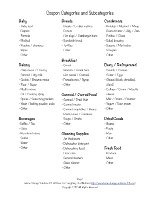 Printable Coupon Categories Index Page |
 Send Expired Coupons To Military |
Want To Do More Decluttering Missions? Get Started With Declutter 365 Today!
Once you declutter one type of item in your home I bet you'll want to declutter some more. After all, decluttering gives you a great reward for even a small investment of time and energy.
The Declutter 365 system is designed to help you declutter, over the course of a year, your entire house, with just 15 minutes of decluttering each day!
Hundreds of thousands of people use this proven system to get rid of their clutter, and bring peace and calm back to their homes.
Declutter 365 works to guide you to clear the clutter without overwhelm, focusing on just one small area at a time, and without making a huge mess in the process, so you see consistent forward progress without all that "messy middle" that makes it even harder to function in your home than before you started.
In addition to building a daily decluttering habit, the Declutter 365 program, along with the accompanying 52 Week Organized Home Challenge, teaches you the skills, habits, routines, and mindsets necessary to maintain the clutter free and organized state of your home from now on, so it'll never be as messy and cluttered as it is right now, ever again.
If you haven't already, make sure to get your copy of this year's Declutter 365 annual calendar here (it's FREE!), find today's date, and do 15 minutes of decluttering on the day's mission. Then, repeat again tomorrow, and again and again. Over the course of the next year, if you do this 15 minutes per day, you'll declutter your whole house!

Get This Bills & Financial Decluttering Checklist + 32 Other Decluttering Checklists For Your Home
Right now you're decluttering papers and other items dealing with your bills and financials, and there's a lot of these types of items around your home.
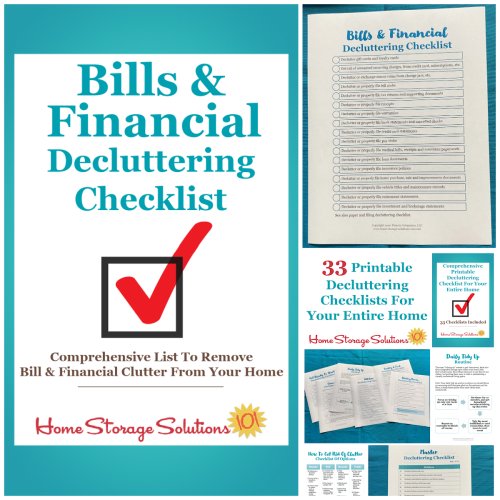
I've done the hard work of breaking down these tasks into smaller more manageable steps for you, so you don't get overwhelmed or worry you're forgetting a task, and you can go at the pace you want, whether that's fast or slow.
In addition, you can tackle these decluttering tasks in whatever order you want when you use these checklists!

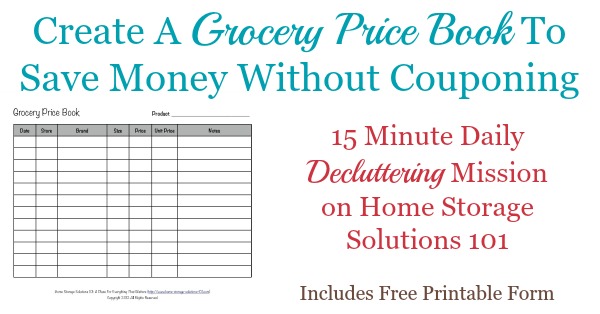
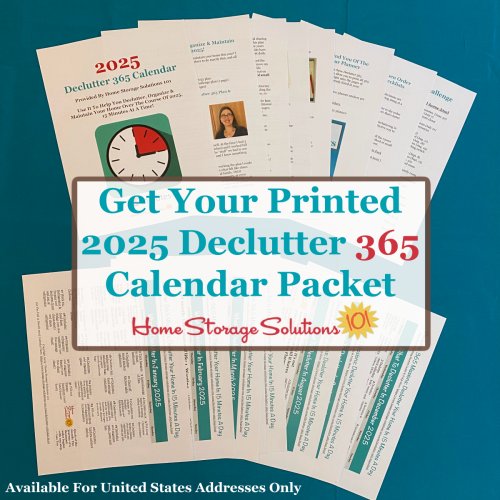
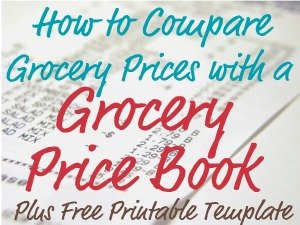
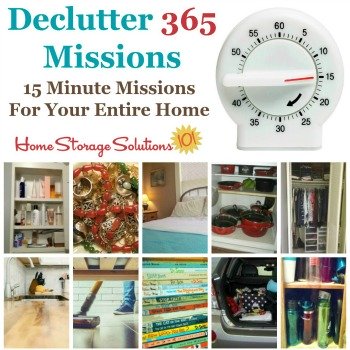
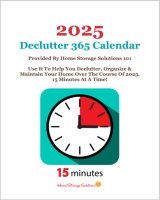
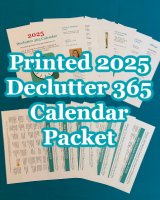
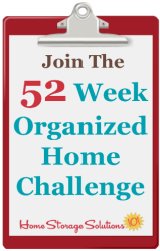



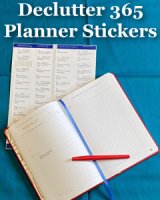




Share Your Comments, Tips & Ideas
I would love to hear from you, sharing your thoughts, questions, or ideas about this topic, so leave me a comment below. I try to always respond back!